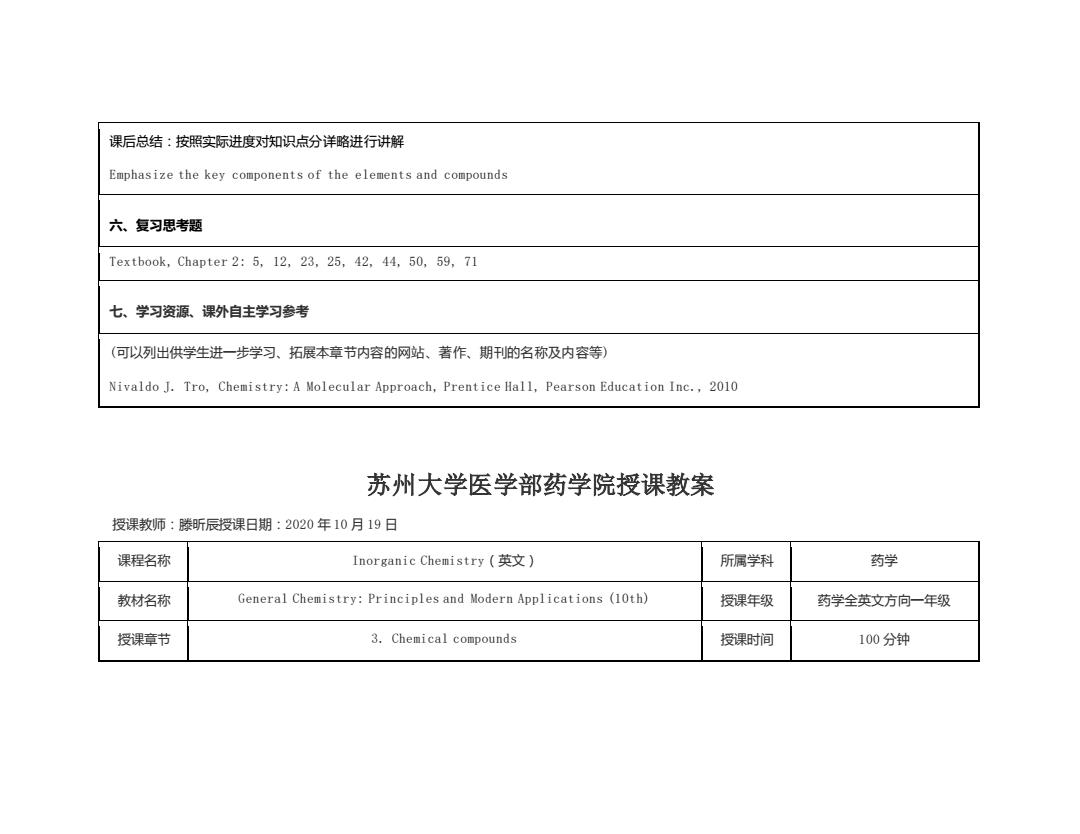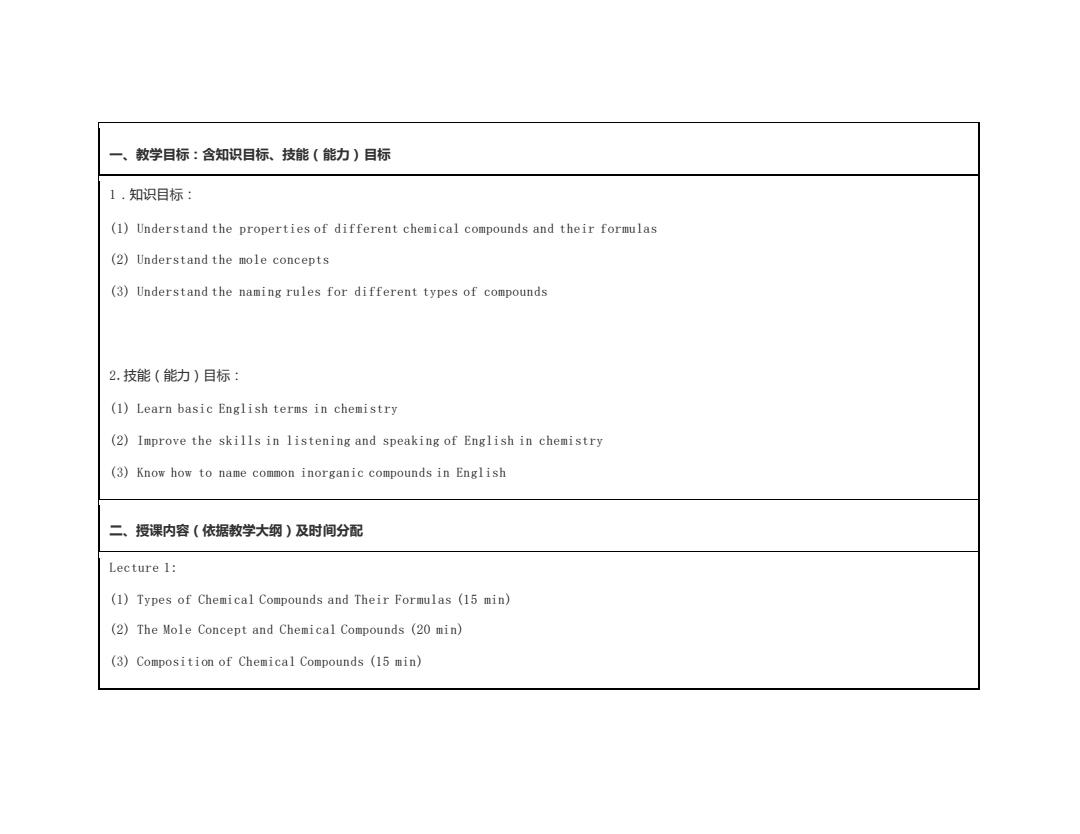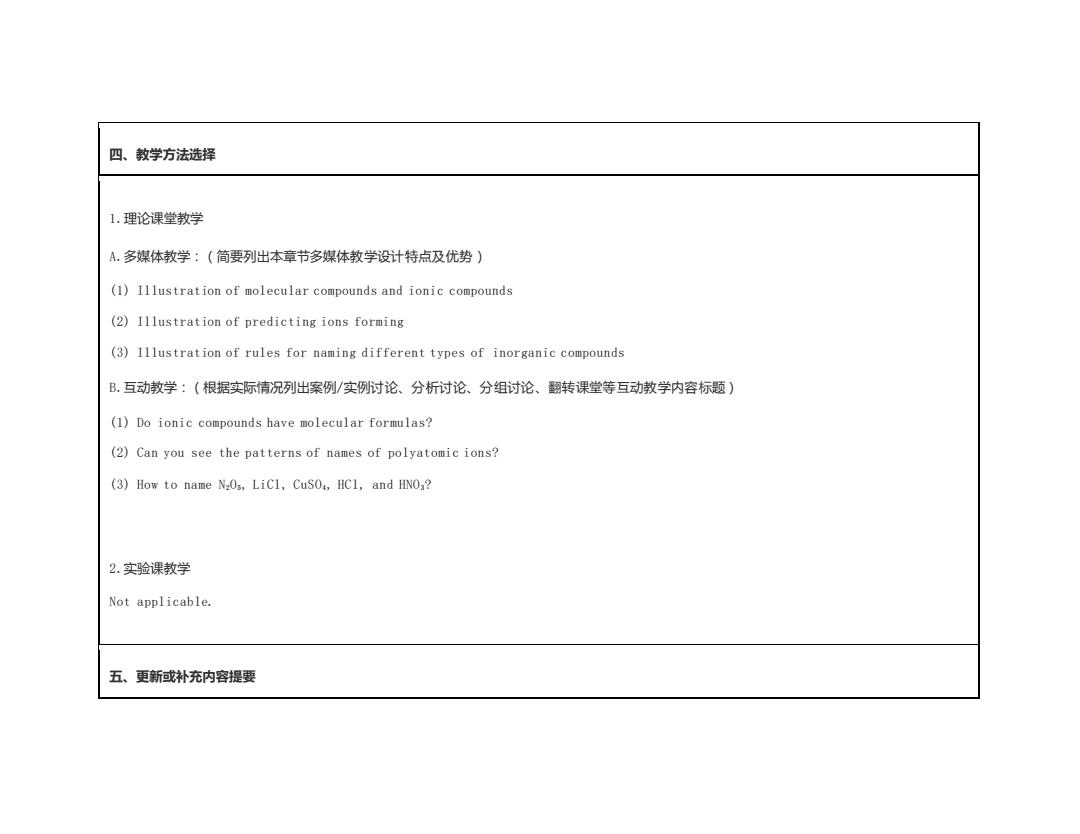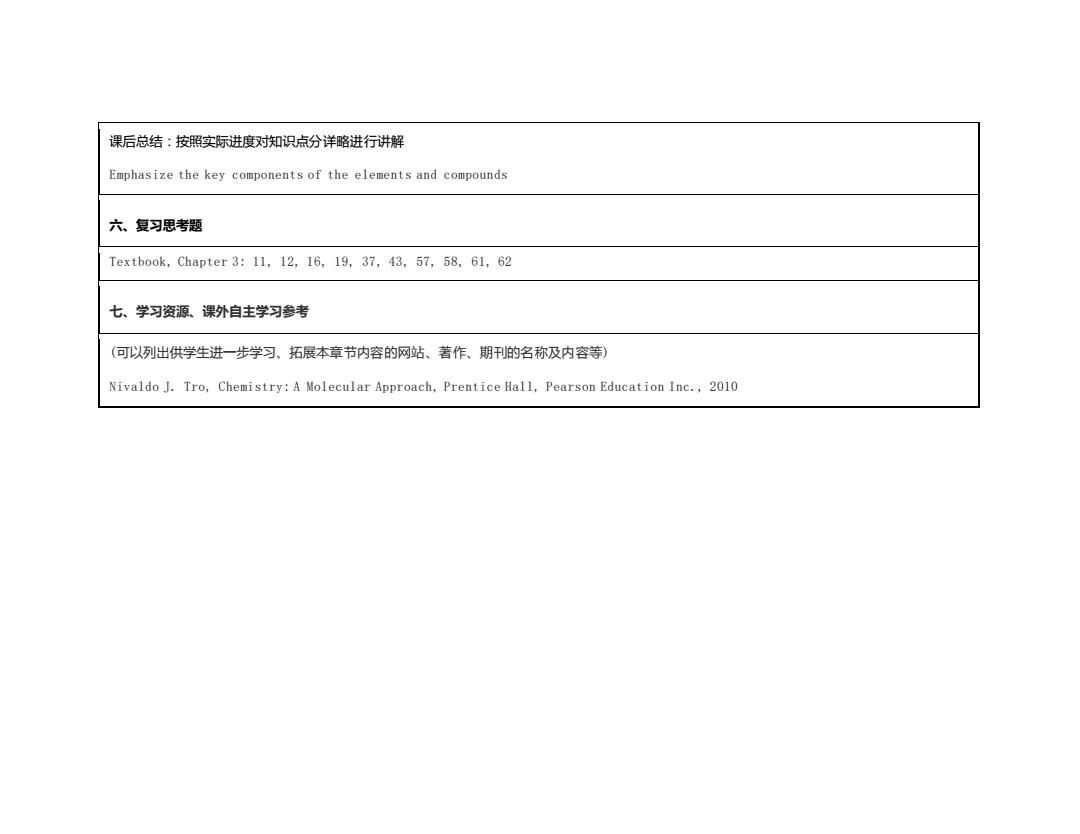
课后总结:按照实际进度对知识点分详略进行讲解 Emphasize the key components of the elements and compounds 六、复习思考题 Textbook,Chapter2:5,12,23,25,42,44,50,59,71 七、学习资源、课外自主学习参考 (可以列出供学生进一步学习、拓展本章节内容的网站、著作、期刊的名称及内容等) Nivaldo J.Tro,Chemistry:A Molecular Approach,Prentice Hall,Pearson Education Inc.,2010 苏州大学医学部药学院授课教案 授课教师:滕昕辰授课日期:2020年10月19日 课程名称 Inorganic Chemistry(英文) 所属学科 药学 教材名称 General Chemistry:Principles and Modern Applications (10th) 授课年级 药学全英文方向一年级 授课章节 3.Chemical compounds 授课时间 100分钟
课后总结:按照实际进度对知识点分详略进行讲解 Emphasize the key components of the elements and compounds 六、复习思考题 Textbook, Chapter 2: 5, 12, 23, 25, 42, 44, 50, 59, 71 七、学习资源、课外自主学习参考 (可以列出供学生进一步学习、拓展本章节内容的网站、著作、期刊的名称及内容等) Nivaldo J. Tro, Chemistry: A Molecular Approach, Prentice Hall, Pearson Education Inc., 2010 苏州大学医学部药学院授课教案 授课教师:滕昕辰授课日期:2020 年 10 月 19 日 课程名称 Inorganic Chemistry(英文) 所属学科 药学 教材名称 General Chemistry: Principles and Modern Applications (10th) 授课年级 药学全英文方向一年级 授课章节 3. Chemical compounds 授课时间 100 分钟

一、教学目标:含知识目标、技能(能力)目标 1.知识目标: (1)Understand the properties of different chemical compounds and their formulas (2)Understand the mole concepts (3)Understand the naming rules for different types of compounds 2.技能(能力)目标: (1)Learn basic English terms in chemistry (2)Improve the skills in listening and speaking of English in chemistry (3)Know how to name common inorganic compounds in English 二、授课内容(依据教学大纲)及时间分配 Lecture 1: (1)Types of Chemical Compounds and Their Formulas (15 min) (2)The Mole Concept and Chemical Compounds (20 min) (3)Composition of Chemical Compounds (15 min)
一、教学目标:含知识目标、技能(能力)目标 1.知识目标: (1) Understand the properties of different chemical compounds and their formulas (2) Understand the mole concepts (3) Understand the naming rules for different types of compounds 2.技能(能力)目标: (1) Learn basic English terms in chemistry (2) Improve the skills in listening and speaking of English in chemistry (3) Know how to name common inorganic compounds in English 二、授课内容(依据教学大纲)及时间分配 Lecture 1: (1) Types of Chemical Compounds and Their Formulas (15 min) (2) The Mole Concept and Chemical Compounds (20 min) (3) Composition of Chemical Compounds (15 min)

Lecture 2: (4)Naming Compounds:Organic and Inorganic Compounds (5 min) (5)Naming molecular compounds (10 min) (6)Naming ionic compounds (15 min) (7)Naming acids (Binary acids;oxyacids)(15 min) (8)Naming hydrates (5 min) 三、教学重点与难点 1.教学重点 (1)Properties of different chemical compounds and their formulas (2)The mole concept and chemical compounds (3)Naming inorganic compounds 2.教学难点 (1)Distinguish between molecular and ionic compounds (2)Naming different types of inorganic compounds
Lecture 2: (4) Naming Compounds: Organic and Inorganic Compounds (5 min) (5) Naming molecular compounds (10 min) (6) Naming ionic compounds (15 min) (7) Naming acids (Binary acids; oxyacids) (15 min) (8) Naming hydrates (5 min) 三、教学重点与难点 1.教学重点 (1) Properties of different chemical compounds and their formulas (2) The mole concept and chemical compounds (3) Naming inorganic compounds 2.教学难点 (1) Distinguish between molecular and ionic compounds (2) Naming different types of inorganic compounds

四、教学方法选择 1.理论课堂教学 A.多媒体教学:(简要列出本章节多媒体教学设计特点及优势) (1)Illustration of molecular compounds and ionic compounds (2)Illustration of predicting ions forming (3)Illustration of rules for naming different types of inorganic compounds B.互动教学:(根据实际情况列出案例/实例时论、分析讨论、分组讨论、翻转课堂等互动教学内容标题) (1)Do ionic compounds have molecular formulas? (2)Can you see the patterns of names of polyatomic ions? (3)How to name N20s,LiCl,CuS0,HC1,and HNO3? 2.实验课教学 Not applicable. 五、更新或补充内容提要
四、教学方法选择 1.理论课堂教学 A.多媒体教学:(简要列出本章节多媒体教学设计特点及优势) (1) Illustration of molecular compounds and ionic compounds (2) Illustration of predicting ions forming (3) Illustration of rules for naming different types of inorganic compounds B.互动教学:(根据实际情况列出案例/实例讨论、分析讨论、分组讨论、翻转课堂等互动教学内容标题) (1) Do ionic compounds have molecular formulas? (2) Can you see the patterns of names of polyatomic ions? (3) How to name N2O5, LiCl, CuSO4, HCl, and HNO3? 2.实验课教学 Not applicable. 五、更新或补充内容提要

课后总结:按照实际进度对知识点分详略进行讲解 Emphasize the key components of the elements and compounds 六、复习思考题 Textbook,Chapter3:11,12,16,19,37,43,57,58,61,62 七、学习资源、课外自主学习参考 (可以列出供学生进一步学习、拓展本章节内容的网站、著作、期刊的名称及内容等) Nivaldo J.Tro,Chemistry:A Molecular Approach,Prentice Hall,Pearson Education Inc.,2010
课后总结:按照实际进度对知识点分详略进行讲解 Emphasize the key components of the elements and compounds 六、复习思考题 Textbook, Chapter 3: 11, 12, 16, 19, 37, 43, 57, 58, 61, 62 七、学习资源、课外自主学习参考 (可以列出供学生进一步学习、拓展本章节内容的网站、著作、期刊的名称及内容等) Nivaldo J. Tro, Chemistry: A Molecular Approach, Prentice Hall, Pearson Education Inc., 2010